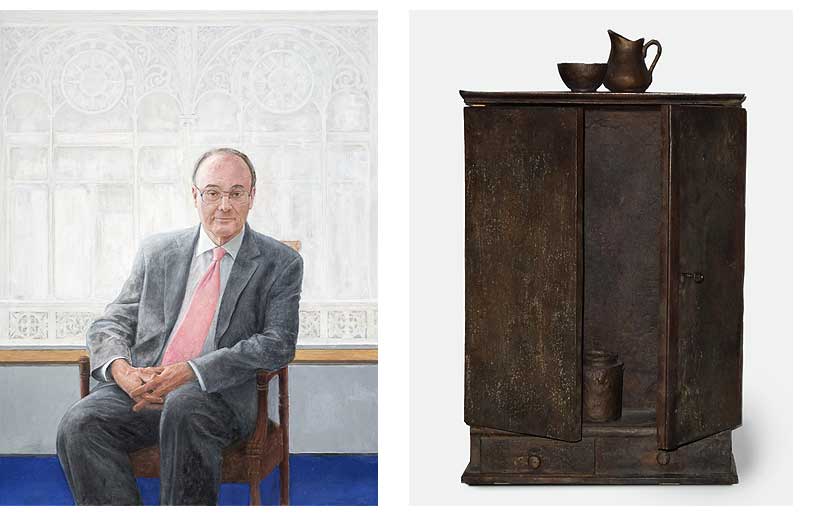
Tribute to Carmen Laffón through her works in the Collection
On Sunday 7 November the sad news emerged that Carmen Laffón had passed away at her home in Sanlúcar de Barrameda (Cadiz). Her legacy as an artist is closely linked with the Banco de España Collection.
Born in Seville, Carmen Laffón was one of the leading lights of Spanish realist painting in the second half of the 20th century. To mark her passing, we present a look at the works by her that form part of our collection: five portraits, an early landscape in oils and a bronze sculpture of a simple kitchen dresser. These works cover the three main genres -portraits, landscapes and still-lifes- on which this "painstaking, poetic artist" (to quote Isabel Tejada's description of her) focused in the course of her career. In 1982 she produced a series of three small etchings for the façade of the Banco de España building on Plaza de Cibeles, considered one of the finest examples of 19th century architecture in the country.
Carmen Laffón's works are lyrical and intimate. She is linked with the group of artists, including José Soto and Teresa Duclós, who introduced Modernism to Seville in the late 1960s. She is known first and foremost for her landscapes, where she shows great skill in depicting light and changes in colour. Mostly, she painted places that meant something to her personally, especially the area between the mouth of the Guadalquivir in Sanlúcar de Barrameda, Doñana natural park and the island of La Cartuja in Seville.
 Carmen Laffón: Seville (1962)
Carmen Laffón: Seville (1962)
The oldest work by her in the bank’s collection is an oil painting dated 1962, entitled Seville. It is both a landscape of her home city and a still-life with a composition reminiscent of Zurbaran. Isabel Tejada sees it as evidence of her leanings towards "humble, everyday themes, which she bathes in golden light to imbue them with excitement".
Carmen Laffón won the National Award for Plastic Arts in 2012 and was declared a "distinguished daughter of Andalusia” in 2013. She was also an accomplished portrait artist. Her portraits, like her landscapes, also show a wide variety of influences in an organic blend of the traditional and the modern and a characteristic, pared-back, brightly-lit style. The Banco de España Collection holds five fine examples of her portrait work.
 Carmen Laffón: Portraits of Juan Carlos I (1987) & Sofia of Greece (1988)
Carmen Laffón: Portraits of Juan Carlos I (1987) & Sofia of Greece (1988)
The oldest are portraits of Spain’s King Juan Carlos I (b. Rome, 1938) and Queen Sofía of Greece (b. Athens, 1938). They date from the late 1980s and were commissioned by the bank. Laffón shies away from the formats usually used in royal portraits and opts instead for an almost square shape that gives a great deal of space to the setting in which the two figures appear. She also avoids the stilted formulae, laden with royal symbols, commonly found in such paintings. The two pictures are intended as a pair. The sitters are shown symmetrically, almost in profile. Isabel Tejada writes that there are, however, major contrasts between them due to the different ways in which Laffón uses shading: the queen is shown mainly in lighter shades and the king in darker ones. The influence of Laffón’s illustrious predecessor Diego de Velázquez, also from Seville, is plain to see.
The other three portraits are of Mariano Rubio Jiménez (b. Burgos, 1931 - d. Madrid, 1999), Luis Ángel Rojo (b. Madrid 1934 - d. Madrid, 2011) and Luis María Linde de Castro (b. Madrid, 1945), the governors of the Banco de España in 1984-1992, 1992-2000 and 2012-2018 respectively. Rubio Jiménez is shown in a three-quarter view, dressed in a dark suit and standing against a bold, red background with flecks of light that focus attention on his face, where the light in the picture is concentrated. Isabel Tejada writes that Carmen Laffón achieves this "in an unforced way, as the sitter’s gaze is fixed on a point out of frame".
 Carmen Laffón: Portraits of Mariano Rubio Jiménez (1991) and Luis Ángel Rojo (1998)
Carmen Laffón: Portraits of Mariano Rubio Jiménez (1991) and Luis Ángel Rojo (1998)
Luis Ángel Rojo is portrayed in a blue-grey suit, seated in an armchair with his arms and legs crossed. In the portrait of Rubio Jiménez there is a sharp contrast between the subject and the background, but here the effect is just the opposite: a uniform atmosphere is created in which things blend into one another. Laffón's delicate, elegant background is particularly interesting: she gives it a lyrical abstraction reminiscent of Mark Rothko, whom she is known to have admired greatly.
The portrait of Luis María Linde de Castro, the penultimate governor of the bank to date, is the most recent work by Laffón in the Collection. Commissioned in 2018 and completed at the height of the pandemic in December 2020, it is thought to be the last institutional portrait that she painted. As a background she takes the former trading floor of the bank's headquarters building at Plaza de Cibeles, which is now the library. The texture and light of the portrait are reminiscent of her series of paintings of the Bonanza salt-marshes in Sanlúcar de Barrameda.
 Carmen Laffón: Portrait of Luis María Linde de Castro (2018-2020) | Bronze dresser I (1995)
Carmen Laffón: Portrait of Luis María Linde de Castro (2018-2020) | Bronze dresser I (1995)
In the 1990s Carmen Laffón also moved into sculpture, and the Banco de España Collection includes one of her works in this medium. Like many Spanish sculptors of her generation, she was fond of using bronze. Bronze dresser I (1995) is a sculpture with a very pictorial feel to it. It represents a kitchen dresser with some simple crockery, and reflects the interest in everyday objects that can also be seen in her early painting Seville.
